Legal Analysis: Misrepresentation, Negligence, and Company Liability
VerifiedAdded on 2021/06/15
|7
|2053
|111
Case Study
AI Summary
This assignment presents a comprehensive case study analysis focusing on two key legal issues: misrepresentation in contract law and negligence in tort law. The first part of the assignment examines a scenario where Jessica, selling her restaurant, misrepresents its annual profits to Angela, leading to a contract. The analysis delves into the elements of misrepresentation, including false statements of fact, intentional deception, inducement, and reliance, ultimately concluding that Angela can cancel the contract. The second part addresses the negligence of Acme Cola Company after Sandra Smith's husband became ill from consuming cola containing cockroach remains. The analysis explores the law of negligence, including duty of care, breach of duty, and causation, referencing the landmark case of Donoghue v Stevenson. It determines that Acme Cola Company is liable for negligence due to a breach of their duty of care, directly causing harm and financial loss to the Smith family, thus allowing them to recover damages. The assignment provides detailed legal reasoning, application of case law, and conclusions for each scenario, demonstrating a clear understanding of the principles of contract and tort law.
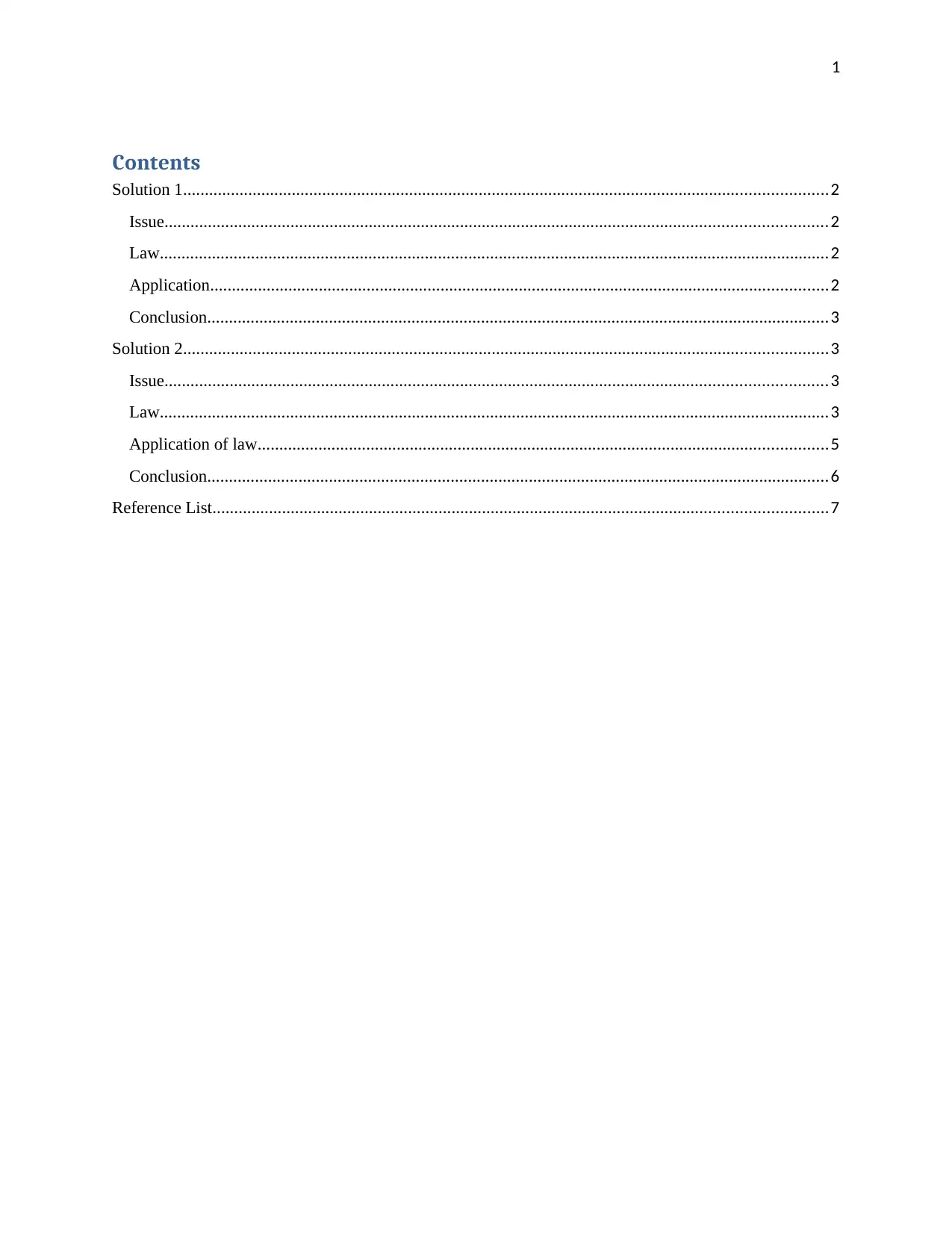
1
Contents
Solution 1....................................................................................................................................................2
Issue........................................................................................................................................................2
Law..........................................................................................................................................................2
Application..............................................................................................................................................2
Conclusion...............................................................................................................................................3
Solution 2....................................................................................................................................................3
Issue........................................................................................................................................................3
Law..........................................................................................................................................................3
Application of law...................................................................................................................................5
Conclusion...............................................................................................................................................6
Reference List.............................................................................................................................................7
Contents
Solution 1....................................................................................................................................................2
Issue........................................................................................................................................................2
Law..........................................................................................................................................................2
Application..............................................................................................................................................2
Conclusion...............................................................................................................................................3
Solution 2....................................................................................................................................................3
Issue........................................................................................................................................................3
Law..........................................................................................................................................................3
Application of law...................................................................................................................................5
Conclusion...............................................................................................................................................6
Reference List.............................................................................................................................................7
Paraphrase This Document
Need a fresh take? Get an instant paraphrase of this document with our AI Paraphraser
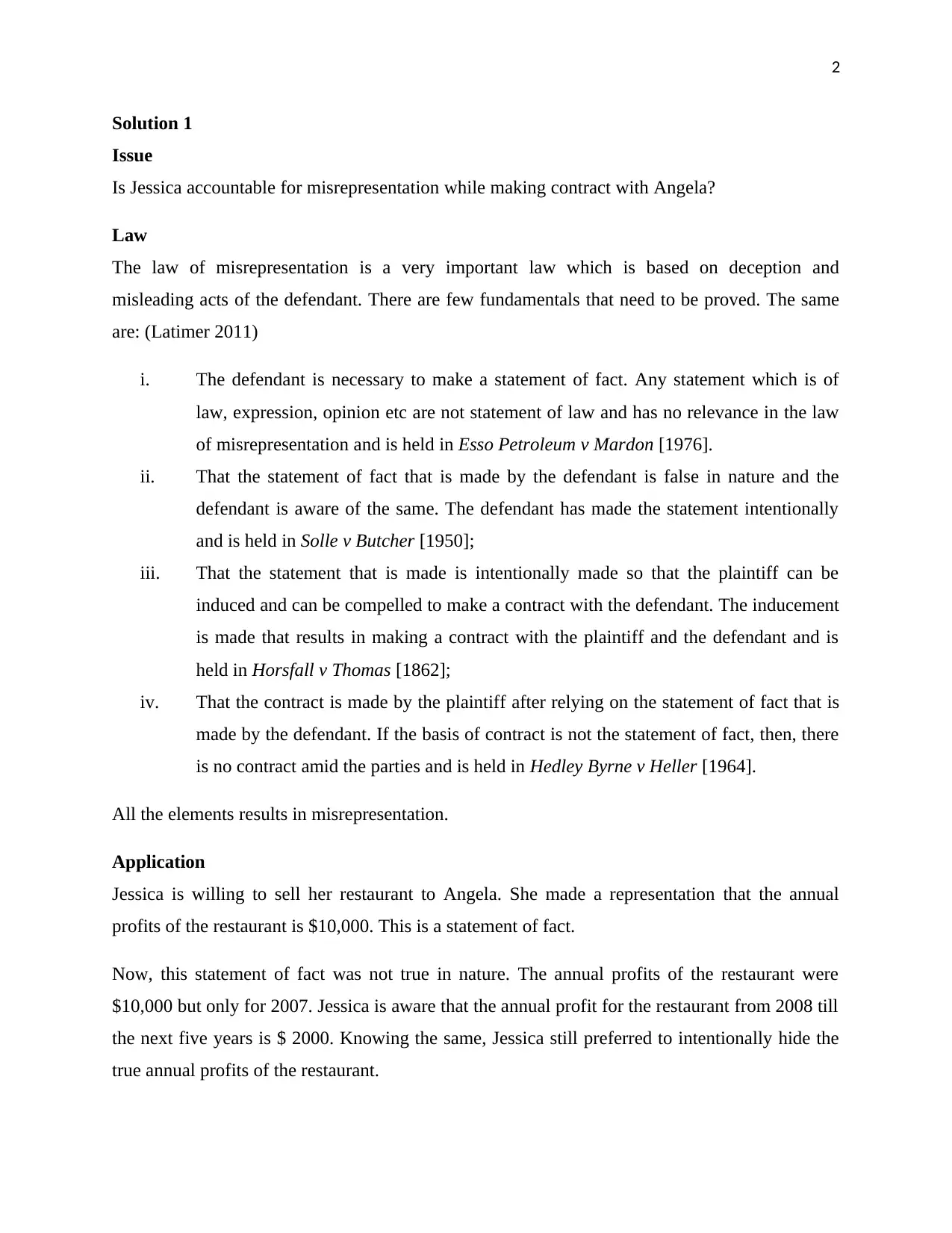
2
Solution 1
Issue
Is Jessica accountable for misrepresentation while making contract with Angela?
Law
The law of misrepresentation is a very important law which is based on deception and
misleading acts of the defendant. There are few fundamentals that need to be proved. The same
are: (Latimer 2011)
i. The defendant is necessary to make a statement of fact. Any statement which is of
law, expression, opinion etc are not statement of law and has no relevance in the law
of misrepresentation and is held in Esso Petroleum v Mardon [1976].
ii. That the statement of fact that is made by the defendant is false in nature and the
defendant is aware of the same. The defendant has made the statement intentionally
and is held in Solle v Butcher [1950];
iii. That the statement that is made is intentionally made so that the plaintiff can be
induced and can be compelled to make a contract with the defendant. The inducement
is made that results in making a contract with the plaintiff and the defendant and is
held in Horsfall v Thomas [1862];
iv. That the contract is made by the plaintiff after relying on the statement of fact that is
made by the defendant. If the basis of contract is not the statement of fact, then, there
is no contract amid the parties and is held in Hedley Byrne v Heller [1964].
All the elements results in misrepresentation.
Application
Jessica is willing to sell her restaurant to Angela. She made a representation that the annual
profits of the restaurant is $10,000. This is a statement of fact.
Now, this statement of fact was not true in nature. The annual profits of the restaurant were
$10,000 but only for 2007. Jessica is aware that the annual profit for the restaurant from 2008 till
the next five years is $ 2000. Knowing the same, Jessica still preferred to intentionally hide the
true annual profits of the restaurant.
Solution 1
Issue
Is Jessica accountable for misrepresentation while making contract with Angela?
Law
The law of misrepresentation is a very important law which is based on deception and
misleading acts of the defendant. There are few fundamentals that need to be proved. The same
are: (Latimer 2011)
i. The defendant is necessary to make a statement of fact. Any statement which is of
law, expression, opinion etc are not statement of law and has no relevance in the law
of misrepresentation and is held in Esso Petroleum v Mardon [1976].
ii. That the statement of fact that is made by the defendant is false in nature and the
defendant is aware of the same. The defendant has made the statement intentionally
and is held in Solle v Butcher [1950];
iii. That the statement that is made is intentionally made so that the plaintiff can be
induced and can be compelled to make a contract with the defendant. The inducement
is made that results in making a contract with the plaintiff and the defendant and is
held in Horsfall v Thomas [1862];
iv. That the contract is made by the plaintiff after relying on the statement of fact that is
made by the defendant. If the basis of contract is not the statement of fact, then, there
is no contract amid the parties and is held in Hedley Byrne v Heller [1964].
All the elements results in misrepresentation.
Application
Jessica is willing to sell her restaurant to Angela. She made a representation that the annual
profits of the restaurant is $10,000. This is a statement of fact.
Now, this statement of fact was not true in nature. The annual profits of the restaurant were
$10,000 but only for 2007. Jessica is aware that the annual profit for the restaurant from 2008 till
the next five years is $ 2000. Knowing the same, Jessica still preferred to intentionally hide the
true annual profits of the restaurant.
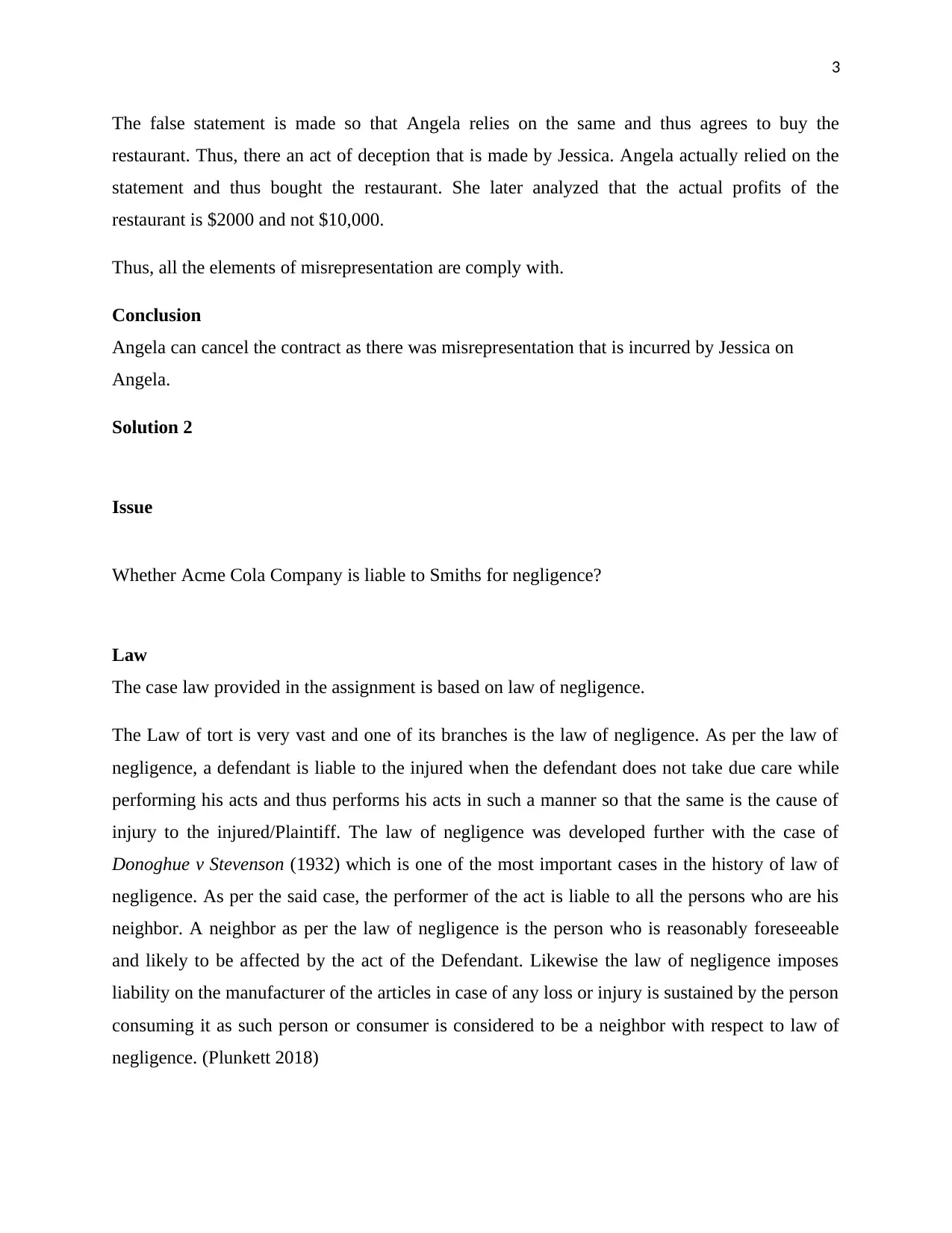
3
The false statement is made so that Angela relies on the same and thus agrees to buy the
restaurant. Thus, there an act of deception that is made by Jessica. Angela actually relied on the
statement and thus bought the restaurant. She later analyzed that the actual profits of the
restaurant is $2000 and not $10,000.
Thus, all the elements of misrepresentation are comply with.
Conclusion
Angela can cancel the contract as there was misrepresentation that is incurred by Jessica on
Angela.
Solution 2
Issue
Whether Acme Cola Company is liable to Smiths for negligence?
Law
The case law provided in the assignment is based on law of negligence.
The Law of tort is very vast and one of its branches is the law of negligence. As per the law of
negligence, a defendant is liable to the injured when the defendant does not take due care while
performing his acts and thus performs his acts in such a manner so that the same is the cause of
injury to the injured/Plaintiff. The law of negligence was developed further with the case of
Donoghue v Stevenson (1932) which is one of the most important cases in the history of law of
negligence. As per the said case, the performer of the act is liable to all the persons who are his
neighbor. A neighbor as per the law of negligence is the person who is reasonably foreseeable
and likely to be affected by the act of the Defendant. Likewise the law of negligence imposes
liability on the manufacturer of the articles in case of any loss or injury is sustained by the person
consuming it as such person or consumer is considered to be a neighbor with respect to law of
negligence. (Plunkett 2018)
The false statement is made so that Angela relies on the same and thus agrees to buy the
restaurant. Thus, there an act of deception that is made by Jessica. Angela actually relied on the
statement and thus bought the restaurant. She later analyzed that the actual profits of the
restaurant is $2000 and not $10,000.
Thus, all the elements of misrepresentation are comply with.
Conclusion
Angela can cancel the contract as there was misrepresentation that is incurred by Jessica on
Angela.
Solution 2
Issue
Whether Acme Cola Company is liable to Smiths for negligence?
Law
The case law provided in the assignment is based on law of negligence.
The Law of tort is very vast and one of its branches is the law of negligence. As per the law of
negligence, a defendant is liable to the injured when the defendant does not take due care while
performing his acts and thus performs his acts in such a manner so that the same is the cause of
injury to the injured/Plaintiff. The law of negligence was developed further with the case of
Donoghue v Stevenson (1932) which is one of the most important cases in the history of law of
negligence. As per the said case, the performer of the act is liable to all the persons who are his
neighbor. A neighbor as per the law of negligence is the person who is reasonably foreseeable
and likely to be affected by the act of the Defendant. Likewise the law of negligence imposes
liability on the manufacturer of the articles in case of any loss or injury is sustained by the person
consuming it as such person or consumer is considered to be a neighbor with respect to law of
negligence. (Plunkett 2018)
⊘ This is a preview!⊘
Do you want full access?
Subscribe today to unlock all pages.

Trusted by 1+ million students worldwide
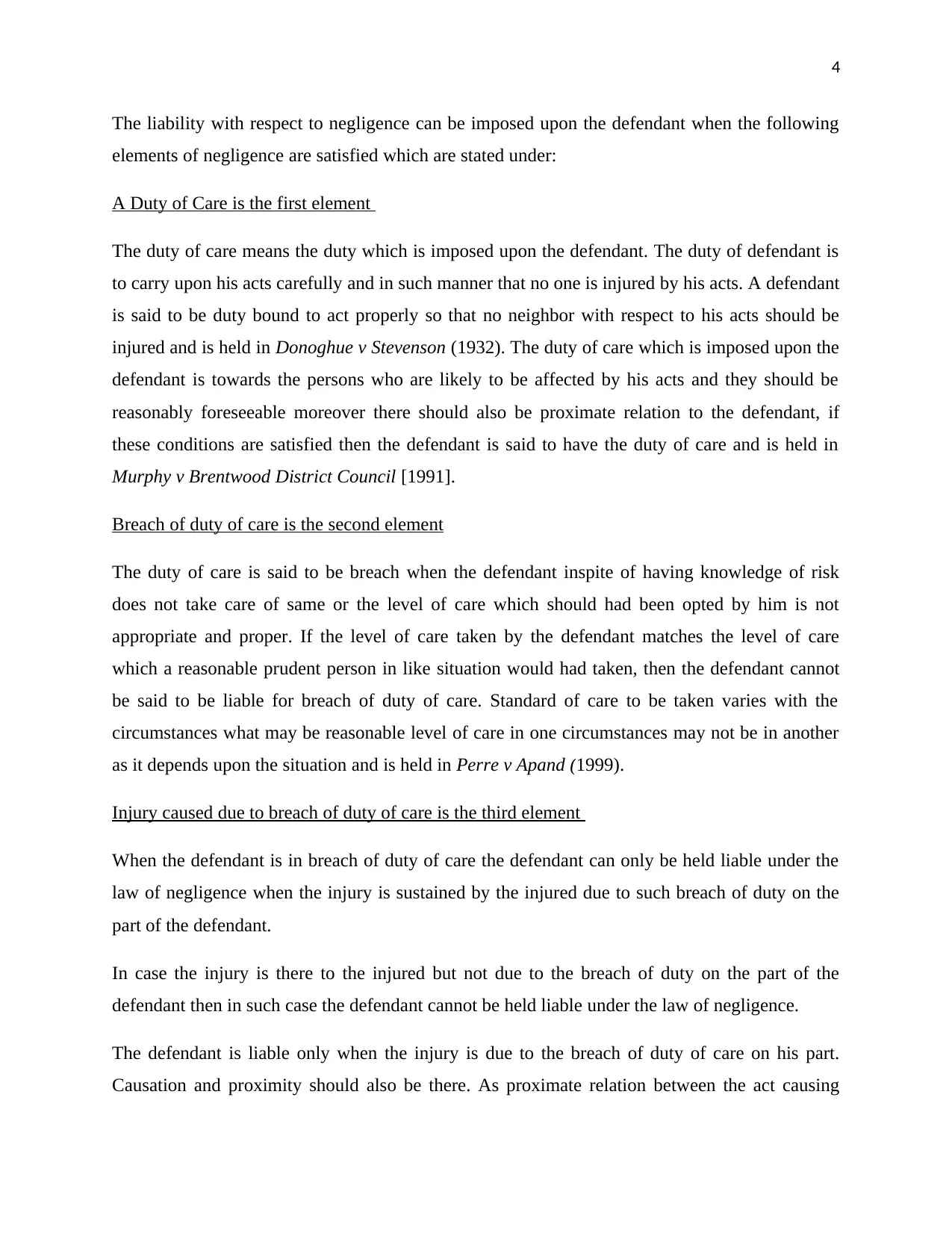
4
The liability with respect to negligence can be imposed upon the defendant when the following
elements of negligence are satisfied which are stated under:
A Duty of Care is the first element
The duty of care means the duty which is imposed upon the defendant. The duty of defendant is
to carry upon his acts carefully and in such manner that no one is injured by his acts. A defendant
is said to be duty bound to act properly so that no neighbor with respect to his acts should be
injured and is held in Donoghue v Stevenson (1932). The duty of care which is imposed upon the
defendant is towards the persons who are likely to be affected by his acts and they should be
reasonably foreseeable moreover there should also be proximate relation to the defendant, if
these conditions are satisfied then the defendant is said to have the duty of care and is held in
Murphy v Brentwood District Council [1991].
Breach of duty of care is the second element
The duty of care is said to be breach when the defendant inspite of having knowledge of risk
does not take care of same or the level of care which should had been opted by him is not
appropriate and proper. If the level of care taken by the defendant matches the level of care
which a reasonable prudent person in like situation would had taken, then the defendant cannot
be said to be liable for breach of duty of care. Standard of care to be taken varies with the
circumstances what may be reasonable level of care in one circumstances may not be in another
as it depends upon the situation and is held in Perre v Apand (1999).
Injury caused due to breach of duty of care is the third element
When the defendant is in breach of duty of care the defendant can only be held liable under the
law of negligence when the injury is sustained by the injured due to such breach of duty on the
part of the defendant.
In case the injury is there to the injured but not due to the breach of duty on the part of the
defendant then in such case the defendant cannot be held liable under the law of negligence.
The defendant is liable only when the injury is due to the breach of duty of care on his part.
Causation and proximity should also be there. As proximate relation between the act causing
The liability with respect to negligence can be imposed upon the defendant when the following
elements of negligence are satisfied which are stated under:
A Duty of Care is the first element
The duty of care means the duty which is imposed upon the defendant. The duty of defendant is
to carry upon his acts carefully and in such manner that no one is injured by his acts. A defendant
is said to be duty bound to act properly so that no neighbor with respect to his acts should be
injured and is held in Donoghue v Stevenson (1932). The duty of care which is imposed upon the
defendant is towards the persons who are likely to be affected by his acts and they should be
reasonably foreseeable moreover there should also be proximate relation to the defendant, if
these conditions are satisfied then the defendant is said to have the duty of care and is held in
Murphy v Brentwood District Council [1991].
Breach of duty of care is the second element
The duty of care is said to be breach when the defendant inspite of having knowledge of risk
does not take care of same or the level of care which should had been opted by him is not
appropriate and proper. If the level of care taken by the defendant matches the level of care
which a reasonable prudent person in like situation would had taken, then the defendant cannot
be said to be liable for breach of duty of care. Standard of care to be taken varies with the
circumstances what may be reasonable level of care in one circumstances may not be in another
as it depends upon the situation and is held in Perre v Apand (1999).
Injury caused due to breach of duty of care is the third element
When the defendant is in breach of duty of care the defendant can only be held liable under the
law of negligence when the injury is sustained by the injured due to such breach of duty on the
part of the defendant.
In case the injury is there to the injured but not due to the breach of duty on the part of the
defendant then in such case the defendant cannot be held liable under the law of negligence.
The defendant is liable only when the injury is due to the breach of duty of care on his part.
Causation and proximity should also be there. As proximate relation between the act causing
Paraphrase This Document
Need a fresh take? Get an instant paraphrase of this document with our AI Paraphraser
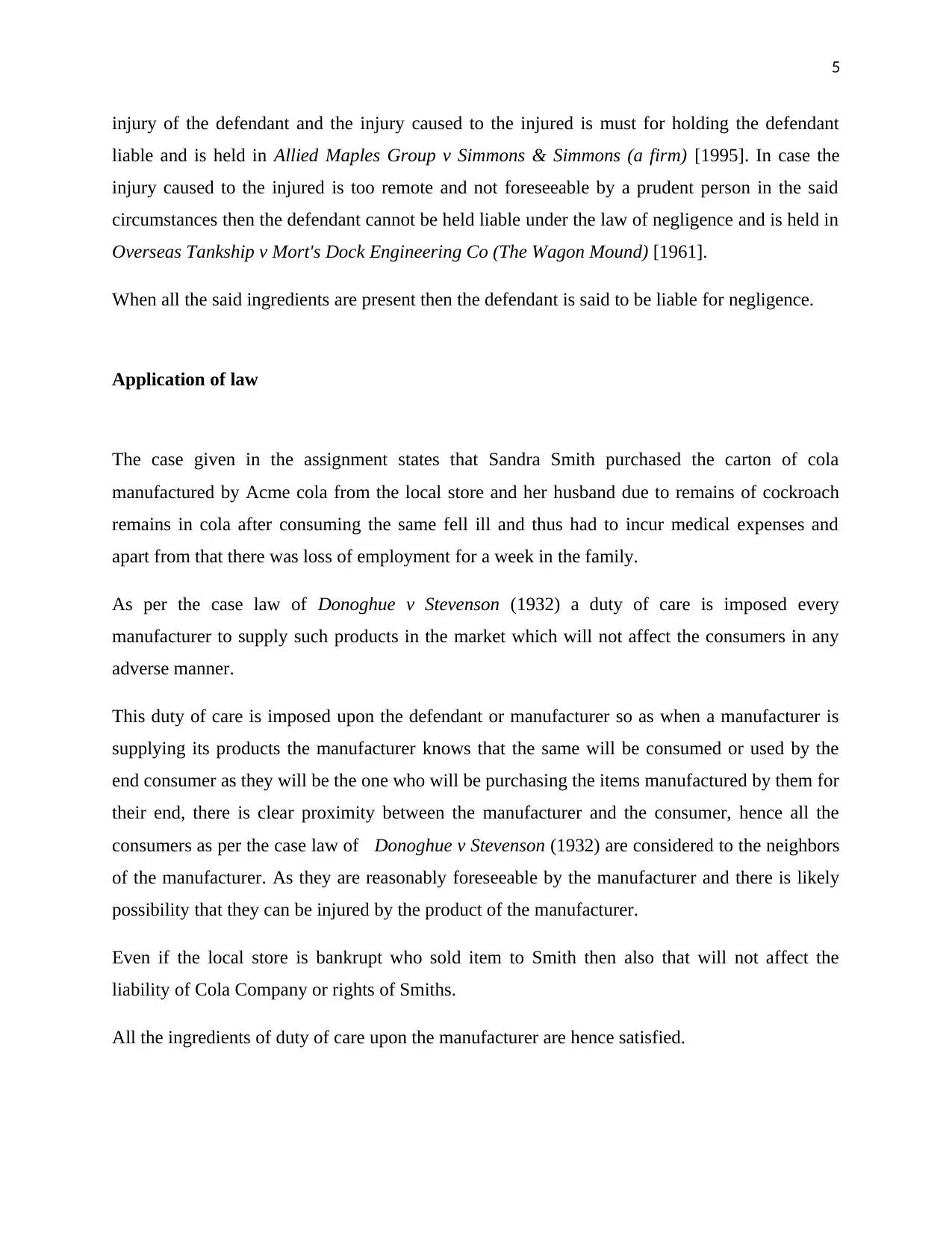
5
injury of the defendant and the injury caused to the injured is must for holding the defendant
liable and is held in Allied Maples Group v Simmons & Simmons (a firm) [1995]. In case the
injury caused to the injured is too remote and not foreseeable by a prudent person in the said
circumstances then the defendant cannot be held liable under the law of negligence and is held in
Overseas Tankship v Mort's Dock Engineering Co (The Wagon Mound) [1961].
When all the said ingredients are present then the defendant is said to be liable for negligence.
Application of law
The case given in the assignment states that Sandra Smith purchased the carton of cola
manufactured by Acme cola from the local store and her husband due to remains of cockroach
remains in cola after consuming the same fell ill and thus had to incur medical expenses and
apart from that there was loss of employment for a week in the family.
As per the case law of Donoghue v Stevenson (1932) a duty of care is imposed every
manufacturer to supply such products in the market which will not affect the consumers in any
adverse manner.
This duty of care is imposed upon the defendant or manufacturer so as when a manufacturer is
supplying its products the manufacturer knows that the same will be consumed or used by the
end consumer as they will be the one who will be purchasing the items manufactured by them for
their end, there is clear proximity between the manufacturer and the consumer, hence all the
consumers as per the case law of Donoghue v Stevenson (1932) are considered to the neighbors
of the manufacturer. As they are reasonably foreseeable by the manufacturer and there is likely
possibility that they can be injured by the product of the manufacturer.
Even if the local store is bankrupt who sold item to Smith then also that will not affect the
liability of Cola Company or rights of Smiths.
All the ingredients of duty of care upon the manufacturer are hence satisfied.
injury of the defendant and the injury caused to the injured is must for holding the defendant
liable and is held in Allied Maples Group v Simmons & Simmons (a firm) [1995]. In case the
injury caused to the injured is too remote and not foreseeable by a prudent person in the said
circumstances then the defendant cannot be held liable under the law of negligence and is held in
Overseas Tankship v Mort's Dock Engineering Co (The Wagon Mound) [1961].
When all the said ingredients are present then the defendant is said to be liable for negligence.
Application of law
The case given in the assignment states that Sandra Smith purchased the carton of cola
manufactured by Acme cola from the local store and her husband due to remains of cockroach
remains in cola after consuming the same fell ill and thus had to incur medical expenses and
apart from that there was loss of employment for a week in the family.
As per the case law of Donoghue v Stevenson (1932) a duty of care is imposed every
manufacturer to supply such products in the market which will not affect the consumers in any
adverse manner.
This duty of care is imposed upon the defendant or manufacturer so as when a manufacturer is
supplying its products the manufacturer knows that the same will be consumed or used by the
end consumer as they will be the one who will be purchasing the items manufactured by them for
their end, there is clear proximity between the manufacturer and the consumer, hence all the
consumers as per the case law of Donoghue v Stevenson (1932) are considered to the neighbors
of the manufacturer. As they are reasonably foreseeable by the manufacturer and there is likely
possibility that they can be injured by the product of the manufacturer.
Even if the local store is bankrupt who sold item to Smith then also that will not affect the
liability of Cola Company or rights of Smiths.
All the ingredients of duty of care upon the manufacturer are hence satisfied.
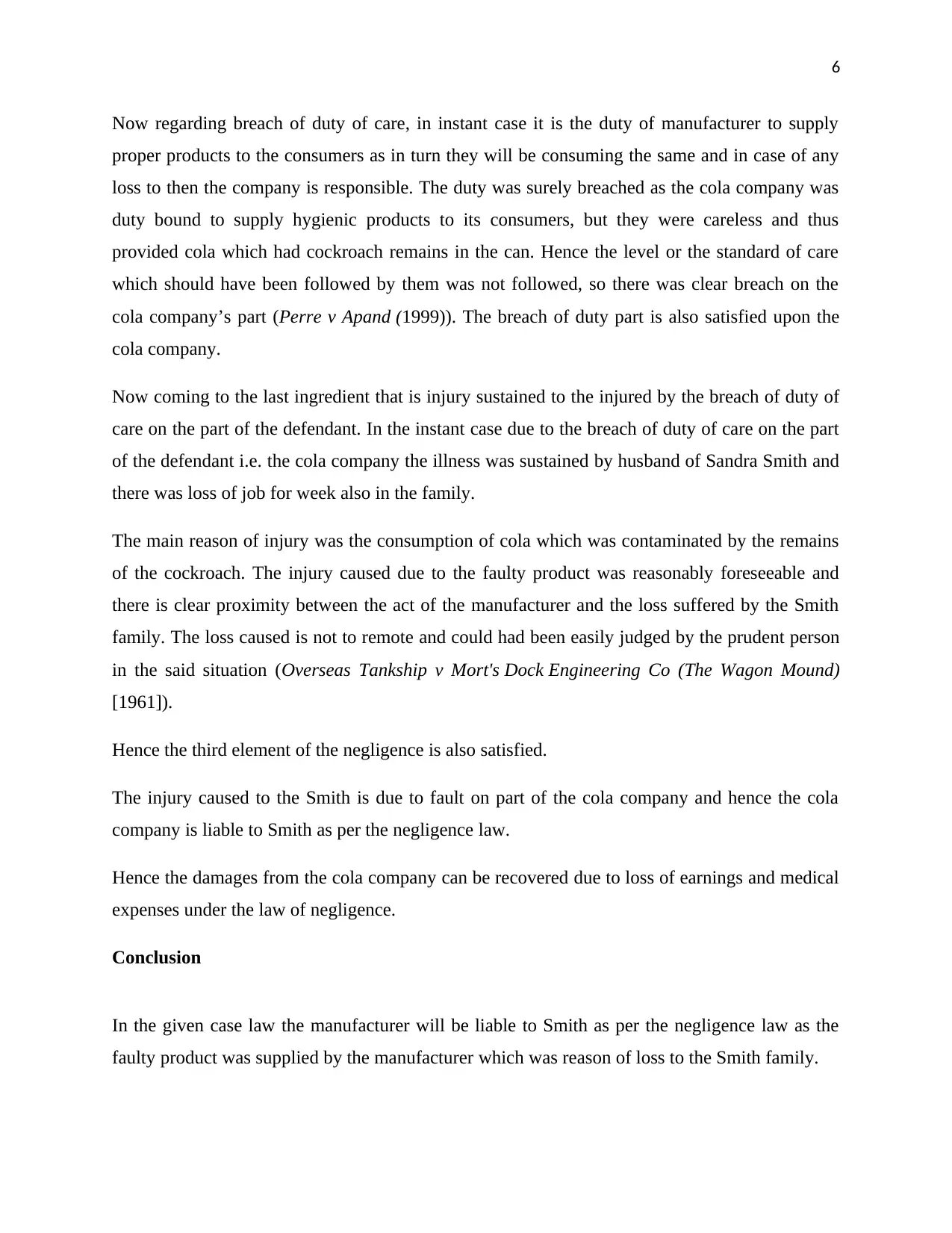
6
Now regarding breach of duty of care, in instant case it is the duty of manufacturer to supply
proper products to the consumers as in turn they will be consuming the same and in case of any
loss to then the company is responsible. The duty was surely breached as the cola company was
duty bound to supply hygienic products to its consumers, but they were careless and thus
provided cola which had cockroach remains in the can. Hence the level or the standard of care
which should have been followed by them was not followed, so there was clear breach on the
cola company’s part (Perre v Apand (1999)). The breach of duty part is also satisfied upon the
cola company.
Now coming to the last ingredient that is injury sustained to the injured by the breach of duty of
care on the part of the defendant. In the instant case due to the breach of duty of care on the part
of the defendant i.e. the cola company the illness was sustained by husband of Sandra Smith and
there was loss of job for week also in the family.
The main reason of injury was the consumption of cola which was contaminated by the remains
of the cockroach. The injury caused due to the faulty product was reasonably foreseeable and
there is clear proximity between the act of the manufacturer and the loss suffered by the Smith
family. The loss caused is not to remote and could had been easily judged by the prudent person
in the said situation (Overseas Tankship v Mort's Dock Engineering Co (The Wagon Mound)
[1961]).
Hence the third element of the negligence is also satisfied.
The injury caused to the Smith is due to fault on part of the cola company and hence the cola
company is liable to Smith as per the negligence law.
Hence the damages from the cola company can be recovered due to loss of earnings and medical
expenses under the law of negligence.
Conclusion
In the given case law the manufacturer will be liable to Smith as per the negligence law as the
faulty product was supplied by the manufacturer which was reason of loss to the Smith family.
Now regarding breach of duty of care, in instant case it is the duty of manufacturer to supply
proper products to the consumers as in turn they will be consuming the same and in case of any
loss to then the company is responsible. The duty was surely breached as the cola company was
duty bound to supply hygienic products to its consumers, but they were careless and thus
provided cola which had cockroach remains in the can. Hence the level or the standard of care
which should have been followed by them was not followed, so there was clear breach on the
cola company’s part (Perre v Apand (1999)). The breach of duty part is also satisfied upon the
cola company.
Now coming to the last ingredient that is injury sustained to the injured by the breach of duty of
care on the part of the defendant. In the instant case due to the breach of duty of care on the part
of the defendant i.e. the cola company the illness was sustained by husband of Sandra Smith and
there was loss of job for week also in the family.
The main reason of injury was the consumption of cola which was contaminated by the remains
of the cockroach. The injury caused due to the faulty product was reasonably foreseeable and
there is clear proximity between the act of the manufacturer and the loss suffered by the Smith
family. The loss caused is not to remote and could had been easily judged by the prudent person
in the said situation (Overseas Tankship v Mort's Dock Engineering Co (The Wagon Mound)
[1961]).
Hence the third element of the negligence is also satisfied.
The injury caused to the Smith is due to fault on part of the cola company and hence the cola
company is liable to Smith as per the negligence law.
Hence the damages from the cola company can be recovered due to loss of earnings and medical
expenses under the law of negligence.
Conclusion
In the given case law the manufacturer will be liable to Smith as per the negligence law as the
faulty product was supplied by the manufacturer which was reason of loss to the Smith family.
⊘ This is a preview!⊘
Do you want full access?
Subscribe today to unlock all pages.

Trusted by 1+ million students worldwide
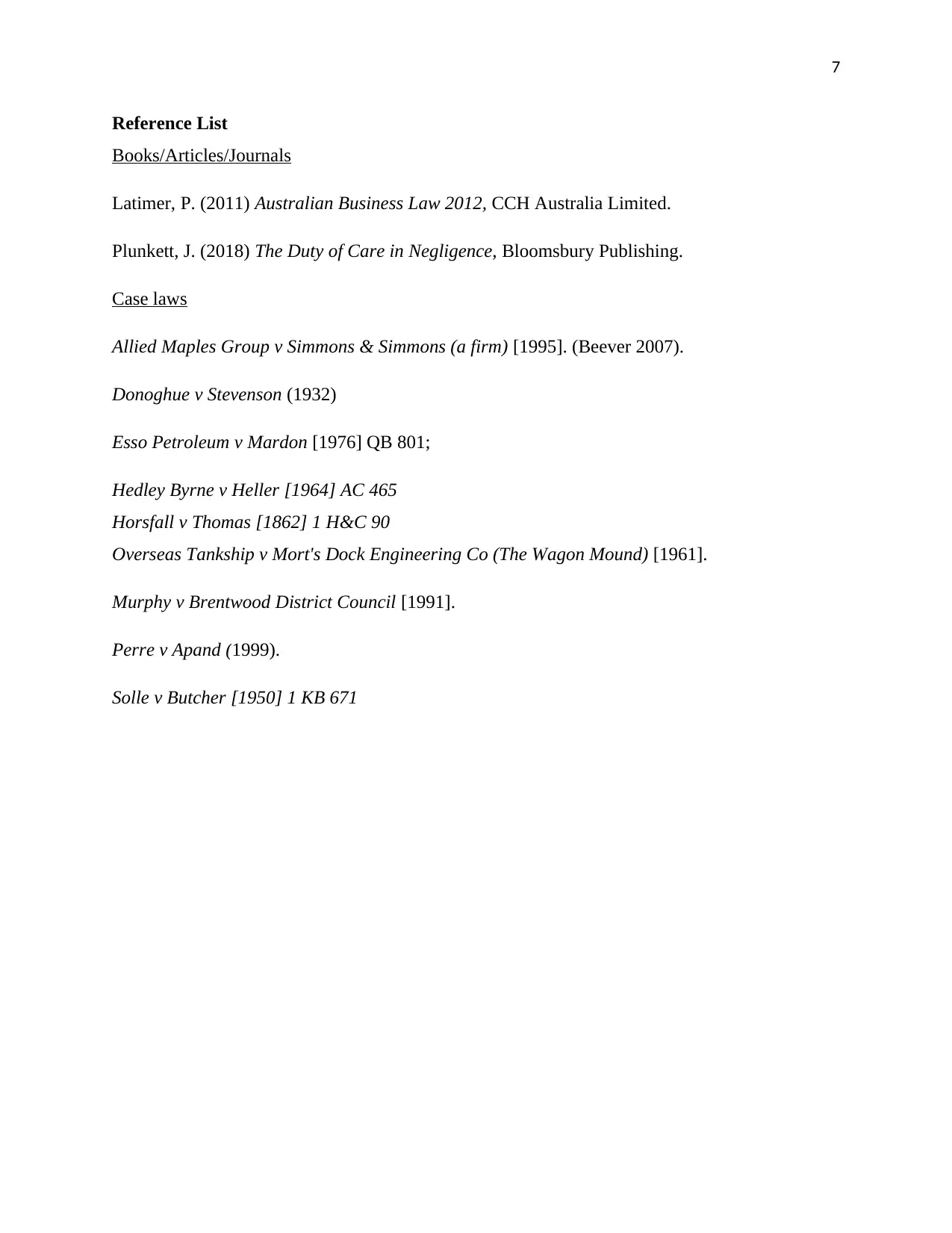
7
Reference List
Books/Articles/Journals
Latimer, P. (2011) Australian Business Law 2012, CCH Australia Limited.
Plunkett, J. (2018) The Duty of Care in Negligence, Bloomsbury Publishing.
Case laws
Allied Maples Group v Simmons & Simmons (a firm) [1995]. (Beever 2007).
Donoghue v Stevenson (1932)
Esso Petroleum v Mardon [1976] QB 801;
Hedley Byrne v Heller [1964] AC 465
Horsfall v Thomas [1862] 1 H&C 90
Overseas Tankship v Mort's Dock Engineering Co (The Wagon Mound) [1961].
Murphy v Brentwood District Council [1991].
Perre v Apand (1999).
Solle v Butcher [1950] 1 KB 671
Reference List
Books/Articles/Journals
Latimer, P. (2011) Australian Business Law 2012, CCH Australia Limited.
Plunkett, J. (2018) The Duty of Care in Negligence, Bloomsbury Publishing.
Case laws
Allied Maples Group v Simmons & Simmons (a firm) [1995]. (Beever 2007).
Donoghue v Stevenson (1932)
Esso Petroleum v Mardon [1976] QB 801;
Hedley Byrne v Heller [1964] AC 465
Horsfall v Thomas [1862] 1 H&C 90
Overseas Tankship v Mort's Dock Engineering Co (The Wagon Mound) [1961].
Murphy v Brentwood District Council [1991].
Perre v Apand (1999).
Solle v Butcher [1950] 1 KB 671
1 out of 7
Related Documents
Your All-in-One AI-Powered Toolkit for Academic Success.
+13062052269
info@desklib.com
Available 24*7 on WhatsApp / Email
![[object Object]](/_next/static/media/star-bottom.7253800d.svg)
Unlock your academic potential
Copyright © 2020–2025 A2Z Services. All Rights Reserved. Developed and managed by ZUCOL.





